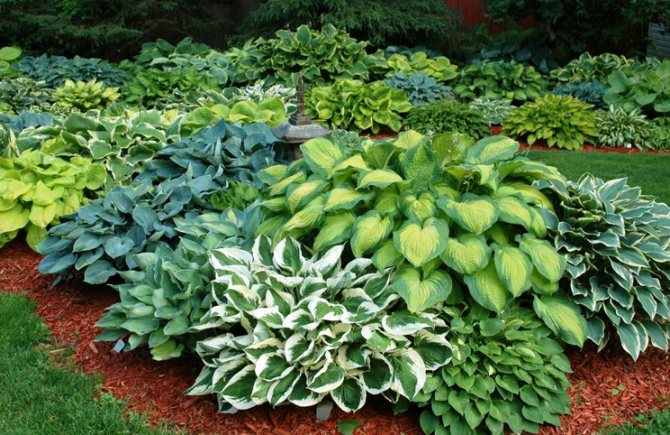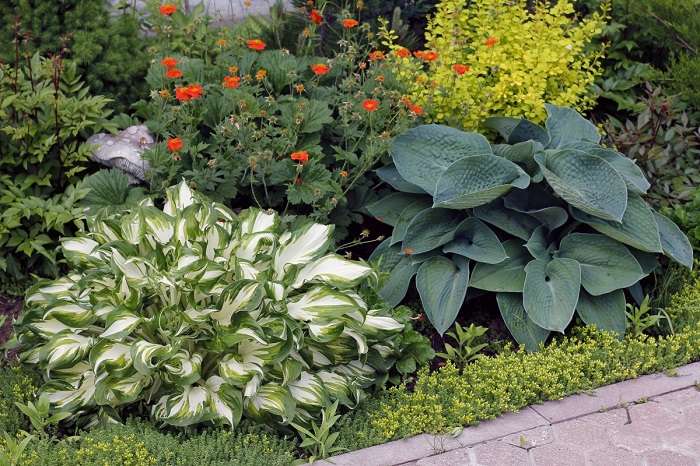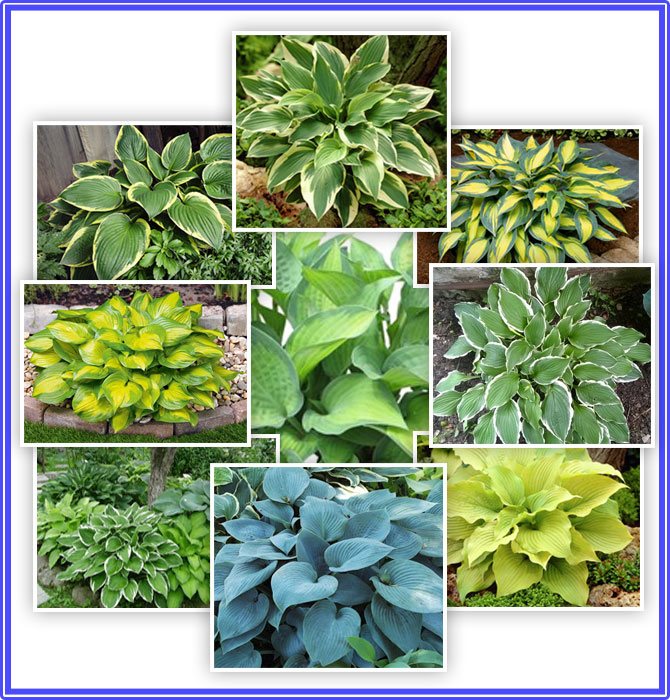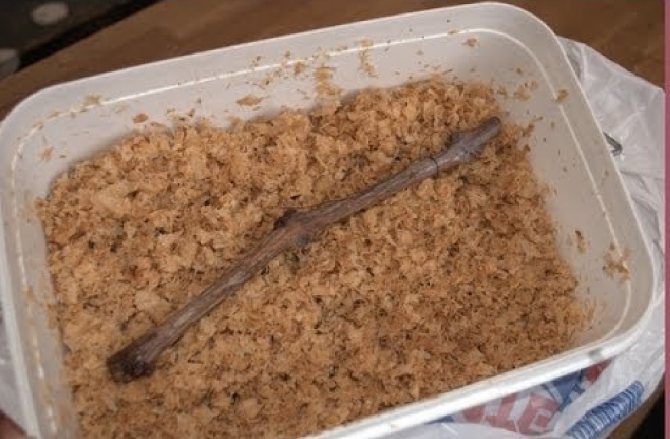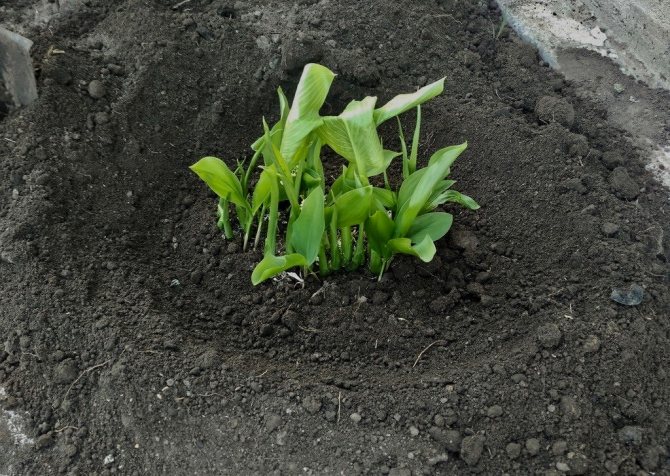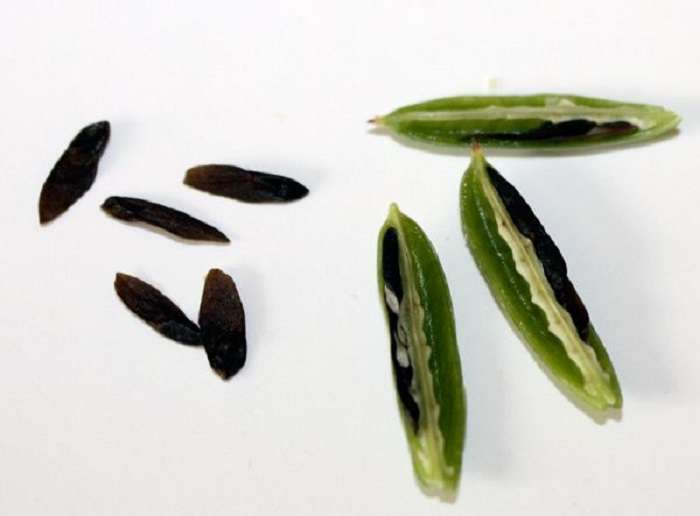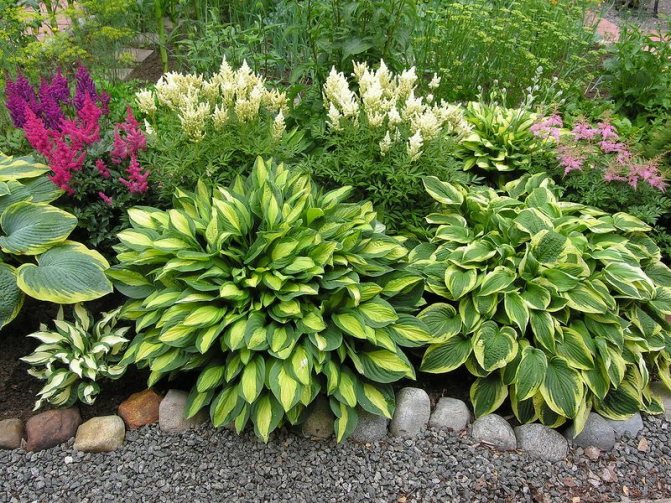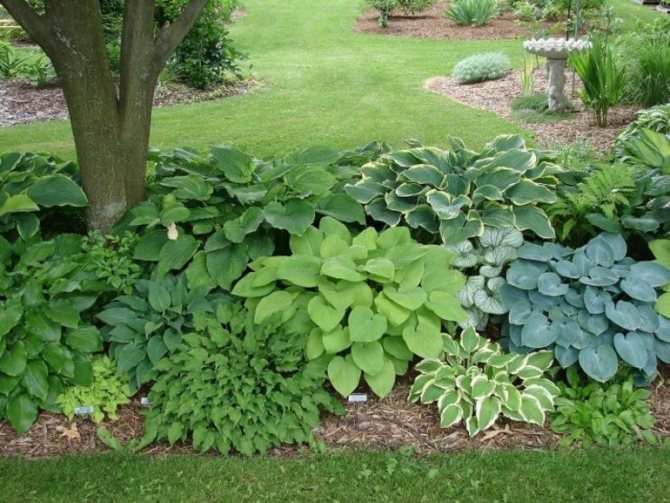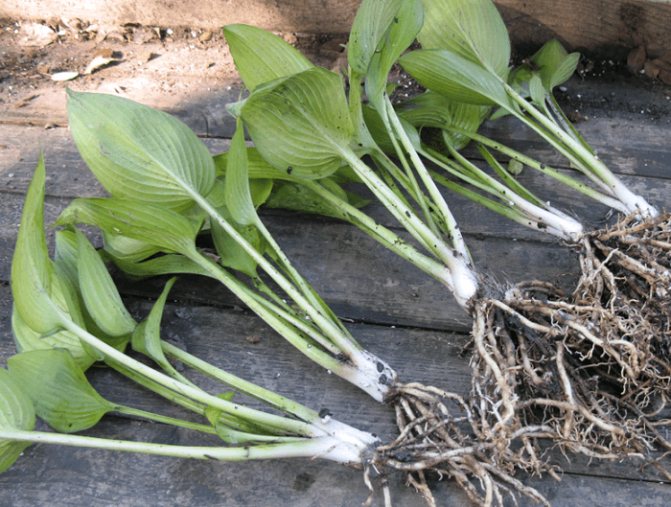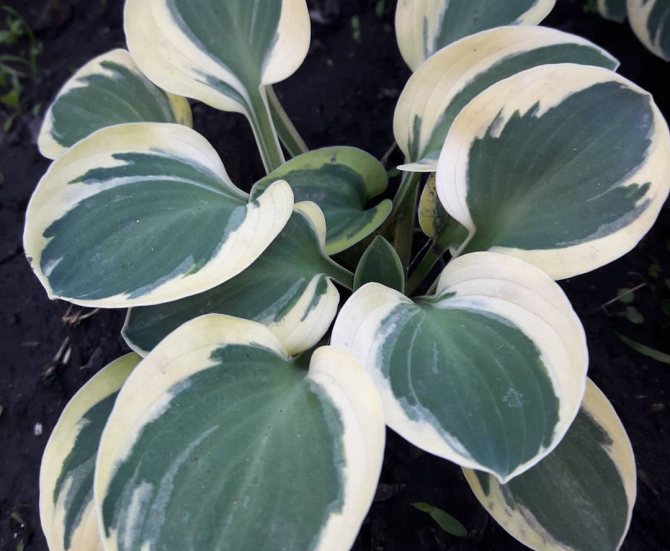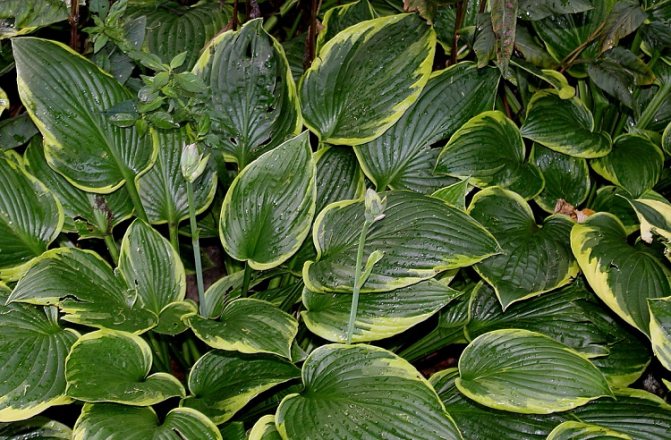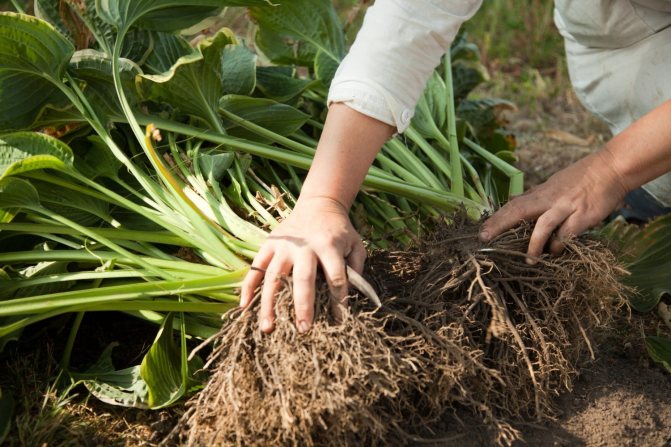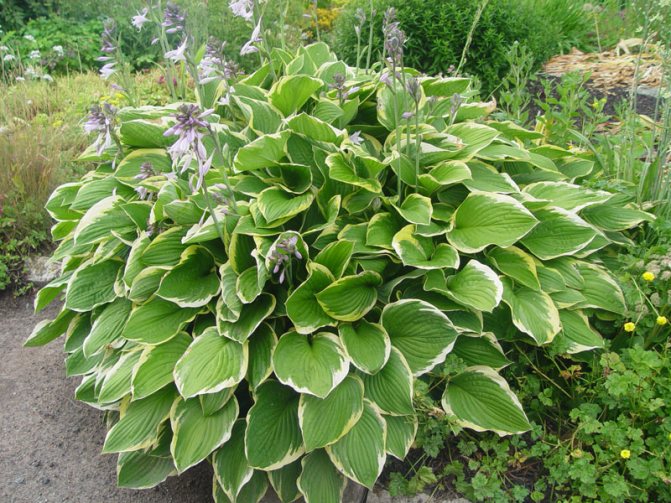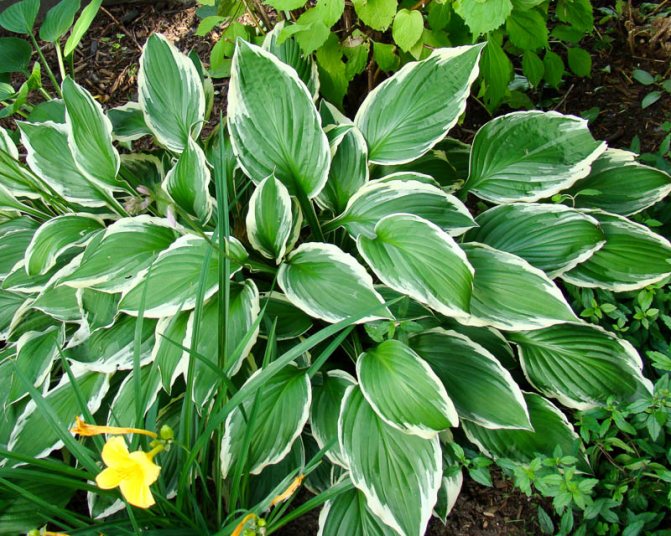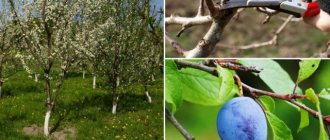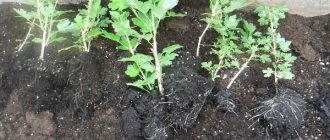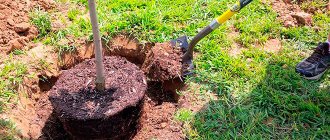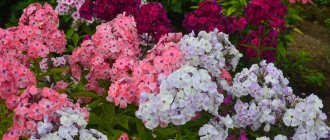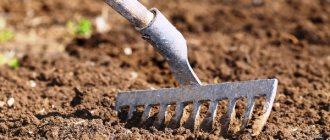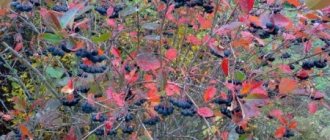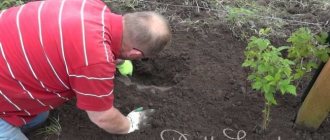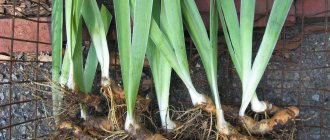An ornamental hosta plant can be an incredible garden decoration. It is very loved by gardeners and landscape designers for its lush foliage, as well as the low cost of material resources, time and physical strength for growing. Its leaves can be of different sizes, shapes and textures. The inflorescences are graceful, stand out above the lush mass of leaves. Their coloration ranges from white to purple and dark blue. To reach its full potential, the plant needs proper care, including periodic replanting.
Variety host
There are about 40 host species and many cultivars that amaze the imagination.
Hosts differ:
- Height (from miniature to the size of a person of average height);
- By color (from soft cream shades to deep green with the presence of yellow, light green, lime, blue shades of different intensities and combinations);
- By the shape of the leaf (lanceolate, round, wavy);
- According to the texture of the sheet (from glossy-smooth to "waffle").
The most popular types of host include: plantain, wavy, white-bordered, straight-leaved, ovate, small, lanceolate, curly, beautiful, Siebold, decorative, tall, swollen.
Recommendations of experienced summer residents
You should not transplant the host to the place where another variety has already grown. This increases the likelihood of diseases, as well as the survival time of the bush.
In order for the bush to have a neat shape and beautiful leaves, young flower arrows need to be broken out for the first few years. After all, most hosts are not grown for flowers, but for ornamental leaves. But this rule does not apply to varieties with white, double flowers (Royal Standard, Fragrant Bouquet, Aphrodite, Summer Fragrance).
Landing hosts
In order for the host to take root well when planting, it is necessary:
- Choose the right landing time. Hosta can be planted in early spring, before the leaves bloom, in early autumn or at the end of summer, so that the plant has time to take root before the cold weather, and as a result - successfully overwinter;
- Select healthy plants for planting. A good planting material on the rhizome should have at least 1 bud, ideally a few, not too overgrown. The roots should be developed, lively and resilient, 10-12 cm long. Examine the plant well to make sure there are no signs of disease. If the plant was purchased in advance and it is still early to plant it, then in this case it must be stored in a cool, dark place, at a temperature within 5-10 degrees (in the basement, refrigerator, on the loggia);
- Find a suitable landing site. Hosta is a shade-loving plant, especially if the color of its foliage is green. Variegated hosts grow well in the sun, but in the midday heat they still require shading;
- Consider and ensure the host's soil requirements. The soil should be light, moist, and breathable. Raw plots for host cultivation are unsuitable. Poor soils are improved by adding humus, sand, mineral fertilizers.
What are the features of preparing hosts for winter in different regions
The southern regions require little or no shelter. The procedure is necessary if the forecast portends any frost. In others, the host situation winters well in vivo.
In the middle lane (Moscow region) and in the Volga region
In the Volga region and the Moscow region, she can survive the winter without much shelter. In these places, it is enough to heap spruce branches and throw snow masses. If winter with severe frosts is expected, then it is advisable to mulch the root system with a thick layer of peat mixed with sawdust.
Also, cut leaves are applied on top, covering them with pine trees. The latter are recommended to be laid on top with bricks or to pull a tourniquet so that the branches are not carried away during strong hurricanes.
In the Urals and Siberia
Siberia and the Urals are characterized by severe frosts and sub-zero temperatures. To insulate hosts in these regions, you will need all the knowledge and skills to shelter a plant. Be sure to dig up the root circle to remove all pests. Lay the surface with mulch. Cover the top with material for covering plants for the winter.
After the snow falls, it is recommended to collect it and pour it over the insulation. It is important that the snow is not frozen, crusty, but crumbly, fresh. Otherwise, sharp snow masses can damage the shelter and provoke freezing of plant growth buds.
Breeding features
The most common and affordable way to breed a host is to divide overgrown bushes.
Bushes are subject to division at the age of 4-6 years. The bush is dug out completely, the soil is shaken off well from the roots. To rejuvenate the hosta, the ends of its roots are slightly trimmed. The rhizome itself is cut with a knife and broken by hand. Fracture points are treated with ash or a fungicide solution, you can sprinkle it with charcoal, cinnamon. The resulting plots are planted in a permanent place with prepared soil.
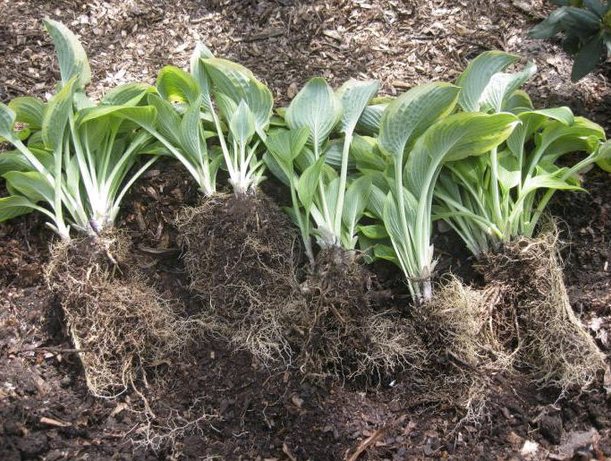
How to transplant correctly
If an adult bush needs to be moved to a new site, before removing it, it is dug in from all sides and, together with a lump of earth, is lifted with a pitchfork.
See also
Description of 25 species and varieties of armeria, planting and care in the open fieldRead
Hosta is bred by dividing from the main plant:
- First, they check for damage on the roots of slugs.
- The bush is washed and dried.
- The dried parts are cut off with pruning shears.
- Immersed in a solution of potassium permanganate.
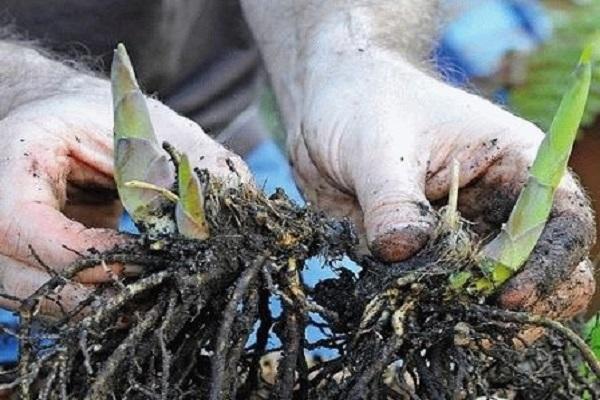

Seedlings with 2 or 3 rosettes of leaves can be separated from the main plant with a disinfected knife. Sections are treated with a fungicide. Hosta will delight you with a decorative view next year.
Transplant hosts in autumn
It is better to transplant the host in the fall at the beginning of the season - September, ideally - until the middle of the month. It takes at least a month to root the plant. There are even host varieties, which are worth replanting exclusively in the fall, because in the spring they simply do not grow roots. These include the hosts of Tokudama and Siebold. These hosts should only be replanted during the fall.
Before planting, the site is dug to the depth of the shovel bayonet. A couple of hours before planting, the site is watered. A hole is made, a mound of fertile soil is poured, 10-15 g of ammonium nitrate, superphosphate, potassium sulfate are added. The larger the bush or plot, the larger the planting hole should be. It is advisable to provide good drainage from pebbles or broken bricks. When planting, the roots are placed on the surface of the mound so that there are no voids under them. Fertile soil is poured on top, compacted, watered abundantly. The plot is placed at the same depth at which the mother plant grew. After planting, the root collar is mulched with humus or peat. Watering is repeated several times after 3-4 days.
If several plants are planted at once, then large varieties should be located at a distance of a meter, and medium ones - half a meter, for dwarf varieties, a distance of 0.2 meters is enough.
When to transplant
In one place the plant lives for years, forming a lush bush with powerful branched roots.In order for the leaves of the hosta to delight with beauty and sophistication, you need to determine the time for transplanting.
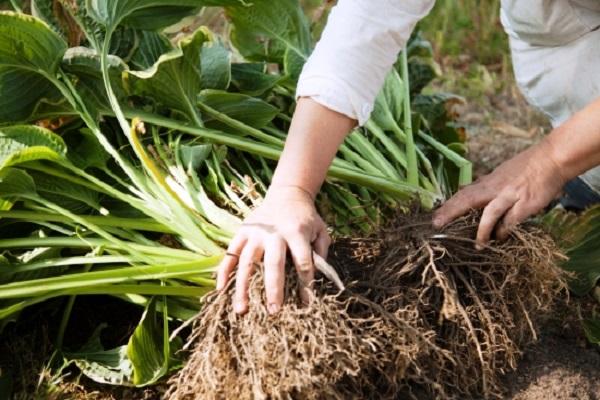

It is moved to another place to avoid:
- thickening of the bush;
- the development of diseases;
- loss of decorativeness.
The plant is transplanted every 5 years, in the first season it is not recommended to divide the rhizome, the hosta does not get used to the new site well and will look unattractive.
When caring for bushes, special knowledge is not required, but it is necessary to transplant the plant at a certain time. In mid-latitudes, work is carried out not earlier than the last days of April in spring, in summer - from late August to early September. In Siberia, the hosta is sent to a new location in the last decade of May.
In the Moscow region, it is better to transplant perennials in the fall. Spring is not suitable for all varieties. The month and date for the procedure are determined taking into account the local climate.
See also
Description of varieties of bulbous irises, planting and care in the open fieldRead
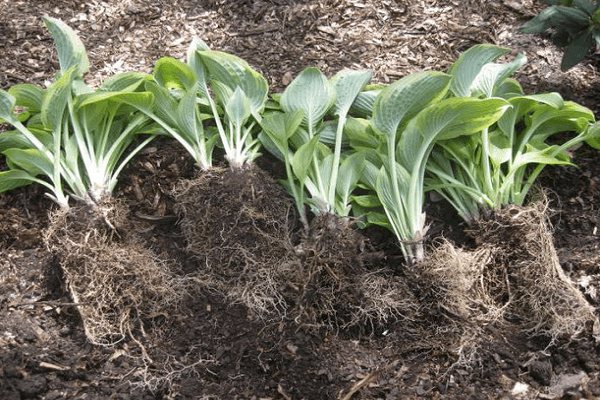

Necessary care
Under natural conditions, hosts grow along rivers, i.e. love moist soil and high humidity.
Hosts need regular watering. Pamper the beautiful host with an evening shower - a good result will not keep you waiting.
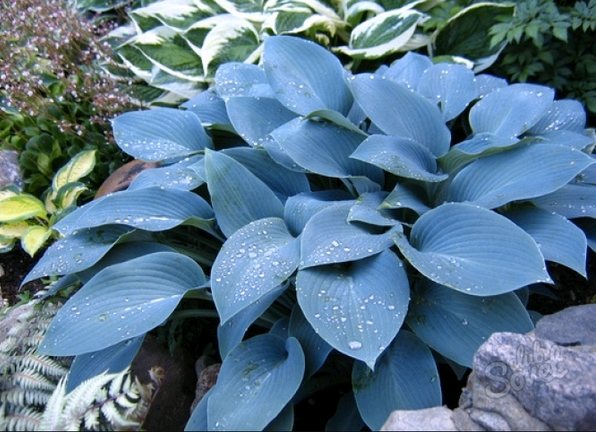

This plant is fed three times per season:
- Spring (beginning of growth);
- When blooming;
- After flowering.
When carrying out dressings, organic fertilizers should be alternated with high-quality mineral dressings.
Regular weeding is necessary in the care. Loosening the soil must be done very carefully. It is recommended to replace it with mulching. After all, mulched soil retains moisture much longer. This option is suitable for weekend summer residents.
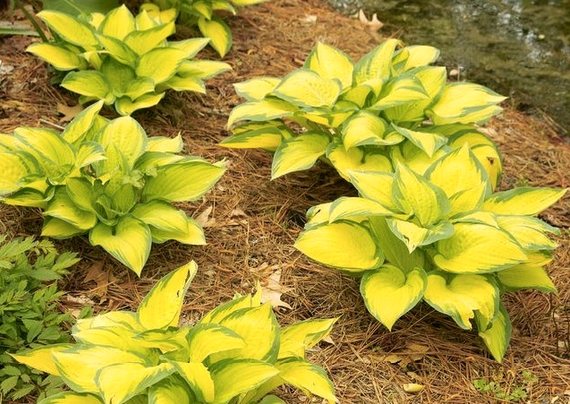

It should be remembered that mulching is not applicable for miniature and dwarf varieties, as it can cause the root collar to heat up.
In addition, mulch is an excellent environment for slugs - the main enemy of beautiful host foliage. Rubble, shell rock, wood chips, which are scattered around the hosta, can help get rid of them, and slugs avoid walking on such surfaces.
Shelter for the winter
Many gardeners are wondering whether to cover the host for the winter. It is worth knowing that the host is subject to shelter. This is especially necessary in the cold regions of our country. Shelter consists of two stages - mulching and shrub insulation.
How to properly cover the host for the winter? The event should be carried out according to the following technology:
- All work should be carried out on a warm, windless day, without precipitation.
- The main condition for carrying out is dry soil.
- The soil around the bush is scooped up under the base.
- The mulch mixture is mixed. It consists of sawdust, old grass, brushwood and peat. All ingredients are taken in equal amounts.
- The batch is poured out next to the root collar, under the very base of the foliage.
- First, tobacco dust is sprayed onto the bush from above, and then irrigated with a chemical insecticide. This will get rid of pests and diseases.
- The bush is covered with material specially produced for this purpose or with improvised means.
- Bricks or stones are laid along the perimeter of the material, from the edges, so as not to damage the growth buds. This helps protect the plant from rodents and strong winds.
Note! An important point in the hosta shelter for the winter is the correct choice of covering material. It is strictly forbidden to wrap the hosta for the winter with roofing material or plastic wrap.
These materials for sheltering hosts for the winter provoke condensation. The latter, in turn, contributes to foliage decay and rotting. Under such conditions, the plant acquires a fungal disease. The result in the spring is the complete death of a beloved green pet.
Attention! For shelter, the host for the winter is suitable for agrofiber, spunbond, old burlap.From above, you can additionally stretch the ropes, which are attached to the pins driven into the ground.
Another method of warming involves placing a large layer of mulch under the plant - 15-17 cm. Pine spruce branches are placed on top of organic feeding. When snow falls, it needs to be collected and piled on the spruce branches with a large snowdrift. This method of sheltering the host for the winter allows you to keep the plant warm for the entire period of winter frosts.
Landscape use
An excellent option for growing a host is growing in conditions close to natural conditions, for example, near a pond among other moisture-loving plants.
The hosts look organically against the background of stones, any wooden decor, in the middle of the lawn. Can be planted as a curb along paths. You can also grow hosts in containers, placing them at the entrance to the house.
Video
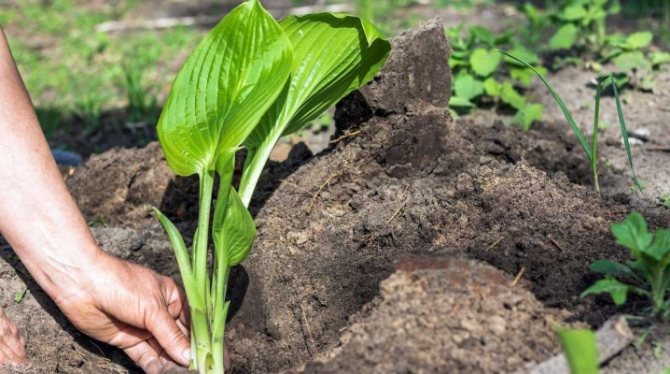

Hosta is a perennial ornamental plant that belongs to the Asparagus family. It is easily recognizable by its large and dense leaves. This flower is often used to decorate personal plots. Unlike many others, this plant is rarely transplanted. If a flower needs to find a new corner in the garden, then it must be transplanted according to all the rules.
Can be divided without extraction
If the task is not to obtain a large number of divisions, then 2-3 new plants can be separated from the original bush without digging it out completely, which, of course, simplifies the process. To neatly separate shoots with 1-4 rosettes, you need to put a sharp shovel in the center of the root system and cut off the necessary part with roots and foliage with a triangle. Often, the daughter branches are located so that it immediately becomes clear how to carry out the separation, of course, you need to take only the strongest shoots.
When you need one cut, you can simply separate it with your hands, after digging the trunk from the outside. Mature shrubs tolerate this procedure, but young hosts, including 3-year-old specimens, may grow more slowly after division so early.
For an illustration of how hosts are multiplied by division, see below.
If the task is not to obtain a large number of divisions, then 2-3 new plants can be separated from the original bush without digging it out completely, which, of course, simplifies the process. To neatly separate shoots with 1-4 rosettes, you need to put a sharp shovel in the center of the root system and cut off the necessary part with roots and foliage with a triangle. Often, the daughter branches are located so that it immediately becomes clear how to carry out the separation, of course, you need to take only the strongest shoots.
When you need one cut, you can simply separate it with your hands, after digging the trunk from the outside. Mature shrubs tolerate this procedure, but young hosts, including 3-year-old specimens, may grow more slowly after division so early.
Preparation of a new site
The land in the garden where the hosta will be grown is freed from weeds. Sandy soil is diluted with peat. Sawdust is introduced into heavy soil, which they managed to overheat. Depleted land is fertilized with ash and trace elements.
To destroy insect larvae, fungal spores, before planting a perennial, the site is watered with a weak solution of potassium permanganate.
The holes for the plant are dug to a depth of 0.4 m and made wide. An interval equal to a meter is left between the bushes of large varieties of perennials, between dwarf species - 30 cm.
Seat selection
The host loves shade; a sprawling and lush perennial grows on such a site. When there are light stripes on the leaves of the bush, it can be planted closer to the sun, but the hosta develops more slowly.
Soil requirement
An ornamental plant takes root in different lands, but loves non-acidic loams, dies in an area where water comes close to the surface. In the sandy soil, the hosta blooms profusely, but develops slowly.
Digging
Having chosen a place in which the ornamental plant will be comfortable, they remove the garbage, rake up the remains of stems and leaves, pull out weeds by the roots, dig up the earth on the bayonet of a shovel.
Fertilizer
Before planting a perennial, organic matter is introduced into the soil. Wood ash is perfect for this purpose; superphosphate or potassium salt is poured into the prepared holes. If the hosta grows in depleted soil, it is fed three times a season with mullein and mineral fertilizers.
Planting pit
The perennial is placed in holes, which are dug to a depth of 0.4 m. The roots of the hosta are placed horizontally. For tall varieties, the pit is made more than a meter wide, for medium-sized bushes - from 50 to 80 cm, for dwarf species - 20 is enough. Expanded clay or crushed stone is poured at the bottom of the hole, the drainage layer is covered with humus.


